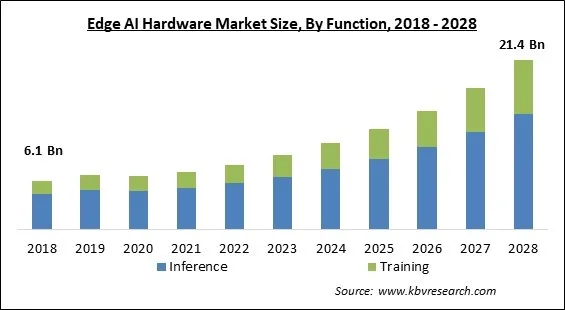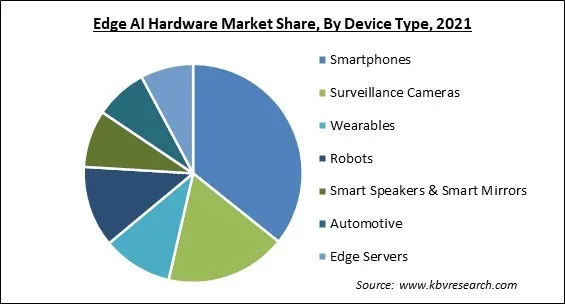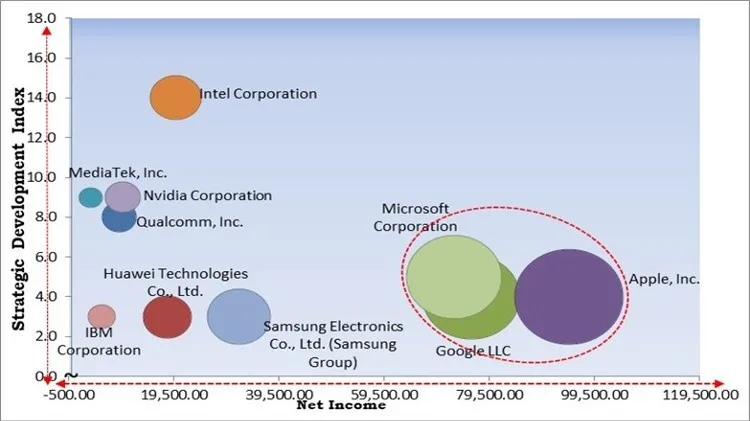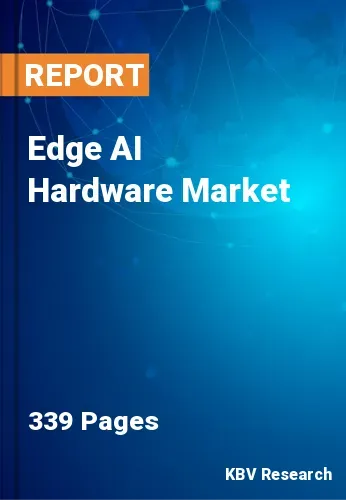The Global Edge AI Hardware Market size is expected to reach $21.4 billion by 2028, rising at a market growth of 17.4% CAGR during the forecast period.
Specialized Edge AI hardware, commonly referred to as AI accelerators, increases data-intensive deep learning inference on Edge devices, making them an attractive choice for many compute-intensive jobs. With the increasing demand for real-time deep learning workloads, specialized Edge AI hardware that enables rapid deep learning on the device has become more and more essential.

In addition, the current standard (cloud-based) AI solution is inadequate for covering bandwidth, ensuring data privacy, and providing low latency. Therefore, AI tasks must be relocated to the Edge. Edge AI may operate on a variety of hardware platforms, ranging from standard MCUs to powerful neural processing processors. Edge AI hardware devices include IoT devices and machines.
Edge AI-connected devices monitor device behavior and gather and evaluate device data using embedded algorithms. The devices will make judgments, automatically resolve issues, and anticipate future performance. All of this is performed without human intervention. In addition to smartphones, laptops, Smart Driven cars, and Raspberry PIs, other examples of Edge AI devices are smartphones, laptops, Smart Driven cars, and Raspberry PIs.
Edge artificial intelligence (edge AI) is a paradigm for designing artificial intelligence (AI) workflows that span centralized data centers (the cloud) and devices outside the cloud that are closer to humans and physical things (the edge). This is in contrast to the common practice of developing and running AI applications wholly in the cloud, which has come to be known as cloud AI. It also varies from traditional techniques to AI development, in which AI algorithms were created on desktops and then deployed on desktops or specialized hardware for tasks such as reading check numbers.
The crisis is causing uncertainty in the stock market, a decline in corporate confidence, a major slowdown in the supply chain, and an increase in customer concern. The breakout of COVID-19 has had a significant influence on the operations of production and manufacturing industries, which in turn has hindered the expansion of the edge AI hardware market. In addition, the COVID-19 pandemic has affected the electronics industry, as production facilities have been halted, which has led to an increase in demand for electronics and semiconductor products among industries. It significantly impacts manufacturing in Europe and Chinese exports, which may impede the market's growth.
In edge AI, machine learning algorithms handle IoT-generated data on near-end devices to solve the issues of excessive latency and insufficient security. A vast amount of data collected by an IoT device is sent to the cloud, where machine learning (ML) models are executed and the processed data is transferred back to the device, which may cause a delay in response. However, AI in the gadget reduces data exchange, allowing for a quicker response.
IT and telecoms are collaborating to deliver new capabilities for high-end apps and reduce network latency with the introduction of 5G networks. The 5G network enables the development of data centers at edge modules and the implementation of industry-specific networks in a single environment using virtualization and software-defined networking principles. Critical AI applications like autonomous vehicles, industrial automation, surgery, and robotics require ultra-low latency.
Currently, pre-trained ML models are employed for inference in edge AI. These models automatically adjust based on user data and requirements. Training a model requires a significant amount of computer power, and because edge AI has limited access to training data, it is more susceptible to uncertainty and unpredictability. In addition, edge AI can perform small transfer learning tasks but cannot perform deep learning tasks. Concerns that cloud computing encounters include latency issues, privacy worries, and bandwidth limitations.

By Device Components, the Edge AI Hardware Market is segmented into Smartphones, Surveillance Cameras, Robots, Wearables, Edge Servers, Smart Speakers, Automotive, and Smart Mirrors. The smartphones segment acquired the highest revenue share in the edge AI hardware market in 2021. Due to the increasing demand for smartphones is anticipated to boost the growth of the edge AI hardware market. Edge AI provides smartphones with enhanced imaging and photography skills, power efficiency, and security.
Based on the Function, the Edge AI Hardware Market is bifurcated into Training and Inference. The inference segment procured the largest revenue share in the edge AI hardware market in 2021. The development of low-power and high-performance CPUs and the rising need for IoT applications have sparked a growing interest in edge artificial intelligence. Reduced latency resulting from the elimination of cloud data transmission is a major driver driving the edge AI market.
On the basis of Vertical, the Edge AI Hardware Market is fragmented into Consumer Electronics, Smart Home, Automotive & Transportation, Government, Healthcare, Industrial, Aerospace & Defense, Construction, and others. The healthcare segment registered a significant revenue share in the edge AI hardware market in 2021. As new initiatives to improve clinical, operational, and financial value across the continuum of care are implemented, the significance of edge computing and analytics will increase.
By Component, the Edge AI Hardware Market is divided into Processor, Memory, and Sensors and others. The memory segment witnessed a substantial revenue share in the edge AI hardware market in 2021. In addition to the growth of new and incumbent memory, including flash storage technologies, several other technological advancements are allowing AI/ML jobs at the edge.
| Report Attribute | Details |
|---|---|
| Market size value in 2021 | USD 7.2 Billion |
| Market size forecast in 2028 | USD 21.4 Billion |
| Base Year | 2021 |
| Historical Period | 2018 to 2020 |
| Forecast Period | 2022 to 2028 |
| Revenue Growth Rate | CAGR of 17.4% from 2022 to 2028 |
| Number of Pages | 339 |
| Number of Tables | 533 |
| Report coverage | Market Trends, Revenue Estimation and Forecast, Segmentation Analysis, Regional and Country Breakdown, Competitive Landscape, Companies Strategic Developments, Company Profiling |
| Segments covered | Function, Device Type, Component, Vertical, Region |
| Country scope | US, Canada, Mexico, Germany, UK, France, Russia, Spain, Italy, China, Japan, India, South Korea, Singapore, Malaysia, Brazil, Argentina, UAE, Saudi Arabia, South Africa, Nigeria |
| Growth Drivers |
|
| Restraints |
|
Region-wise, the Edge AI Hardware Market is analyzed across North America, Europe, Asia Pacific, and LAMEA. The Asia Pacific segment procured the highest revenue share in the edge AI hardware market in 2021. China is the largest artificial intelligence market in the Asia-Pacific area, followed by Japan; this makes the region a promising market for edge AI hardware applications. The presence of a high number of manufacturing businesses in China and Japan, in addition to the strong presence of automobile, electronics, and semiconductor industries, promotes the growth of the edge AI hardware market in the Asia Pacific.
Free Valuable Insights: Global Edge AI Hardware Market size to reach USD 21.4 Billion by 2028

The major strategies followed by the market participants are Product Launches. Based on the Analysis presented in the Cardinal matrix; Apple, Inc. and Microsoft Corporation are the forerunners in the Edge AI Hardware Market. Companies such Samsung Electronics Co., Ltd., Intel Corporation and Huawei Technologies Co., Ltd. are some of the key innovators in Edge AI Hardware Market.
The market research report covers the analysis of key stake holders of the market. Key companies profiled in the report include Apple, Inc., MediaTek, Inc., Qualcomm, Inc., Huawei Technologies Co., Ltd., Samsung Electronics Co., Ltd. (Samsung Group), Intel Corporation, Nvidia Corporation, IBM Corporation, Google LLC, and Microsoft Corporation.
By Function
By Device Type
By Component
By Vertical
By Geography


The global Edge AI Hardware Market size is expected to reach $21.4 billion by 2028.
Mission-Critical Applications Necessitating Minimal Latency And Real-Time Data Transmission are driving the market in coming years, however, Limitations Associated With AI Edge Devices restraints the growth of the market.
Apple, Inc., MediaTek, Inc., Qualcomm, Inc., Huawei Technologies Co., Ltd., Samsung Electronics Co., Ltd. (Samsung Group), Intel Corporation, Nvidia Corporation, IBM Corporation, Google LLC, and Microsoft Corporation.
The expected CAGR of the Edge AI Hardware Market is 17.4% from 2022 to 2028.
The Processor segment acquired maximum revenue share in the Global Edge AI Hardware Market by Component in 2021 thereby, achieving a market value of $10.5 billion by 2028.
The Asia Pacific market dominated the Global Edge AI Hardware Market by Region in 2021, and would continue to be a dominant market till 2028; thereby, achieving a market value of $8.1 billion by 2028.
Our team of dedicated experts can provide you with attractive expansion opportunities for your business.

